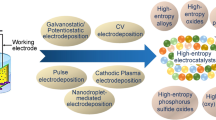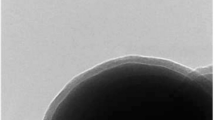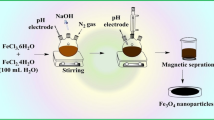Abstract
The participation of solid Fe powder particles in the transfer of charge through a heterogeneous system consisting of an electrolyte and conducting powder particles was studied by means of electrochemical impedance spectroscopy and conductivity measurements. Different behaviour was encountered in electroinactive Na2SO4 electrolyte without metal electrodeposition on the Fe particles and in NiSO4 electrolyte where Ni electrodeposition occurs on the Fe particle surfaces. From impedance diagrams and the proposed model the formation of aggregates and chains of Fe particles is deduced. The important role of electrochemical reaction proceeding at the particle surface in the charge transfer behaviour in stirred heterogeneous systems was also demonstrated.















Similar content being viewed by others
References
Sabacky BJ, Evans JW (1977) Metall Trans 8B:5
Fleischmann M, Oldfield JW (1971) J Electroanal Chem 29:231
Beenackers AA, van Swaaij WP, Welmers A (1977) Electrochim. Acta 22:1277
Huh T, Evans JW (1978) J Electrochem Soc 134:308
Huh T, Evans JW (1987) J Electrochem Soc 134:317
Plimley RE, Wright AR (1984) Chem Eng Sci 39:395
Gabrielli C, Huet F, Sarah A and Valentin G (1992) J Appl Electrochem 22: 801
Gálová M, OriňákováR, Lux L (1998) J Solid State Electrochem 2:2
Gál M, Gálová M, Turoňová A (2000) Collect Czech Chem Commun 65:1515
Lux L, Gálová M, Oriňáková R, Turoňová A (1998) Particul Sci Technol 16:135
Oriňáková R (2003) Surf Coat Technol 162:54
Gál MF (2004) PhD thesis, Slovak University of Technology, Bratislava
Roušar I, Micka K, Kimla A (1986) Electrochemical engineering 2. Academia Praha, p 93
Pospíšil L, Fiedler J, Fanelli N (2000) Rev Sci Instrum 71:1804
Bockris JO’M, Kim J (1997) J Appl Electrochem 27:890
Gabrielli C, Huet F, Sarah A, Valentin G (1994) J Appl Electrochem 24:481
Acknowledgements
The authors express their gratitude to the Grant Agency of the Slovak Republic for financial support of projects 1/ 9038/02 and 1/9425/02.
Author information
Authors and Affiliations
Corresponding author
Appendix
Appendix
1.1 Derivation of the total impedance Z T of the system according to Figs. 9 and 10
The total impedance of the system is the sum of the electrolyte impedance Z el , contact impedance Z con , interfacial impedance Z as depicted in Fig. 8. Also the outer impedance Z out of the system should be included in the expression for Z T .
For the partial impedances Z out , Z el , Z con , Z according Figs. 9 and 10 it can be written
where
Z dl is double-layer impedance, Z ct charge transfer impedance and Z dif diffusion impedance.
Applying the Moivre theorem \({(a+bi)^{1/n}=r^{1/n}\left( {\cos \frac{2l \pi +\varphi }{n}+{i}\sin \frac{2l\pi +\varphi }{n}} \right)}\)
where \({l=0,1,2\ldots (n−1);\quad r=({a}^2+{b}^2)^{1/2};\quad \tan \varphi =\frac{b}{a}}\) and if
\({\sqrt {i} }\) can be rewritten as \({\frac{1+i}{\sqrt {2} }}\) and then
After combining Eqs. A.8–A.10 we obtain an expression for Z dif
where \({\alpha =B\sqrt {\frac{\omega }{2}} }\) .
Then the expression for the total impedance Z T can be derived as
Rights and permissions
About this article
Cite this article
Gál, M.F., Híveš, J., Benová, M. et al. Electrochemical impedance and conductivity measurements in a heterogeneous Fe powder particle—electrolyte system with or without electrochemical reaction. J Appl Electrochem 37, 737–746 (2007). https://doi.org/10.1007/s10800-007-9306-4
Received:
Revised:
Accepted:
Published:
Issue Date:
DOI: https://doi.org/10.1007/s10800-007-9306-4




